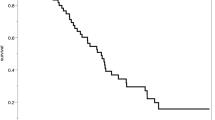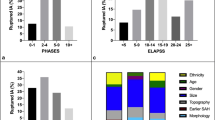Abstract
Background
Although rupture of intracranial aneurysms carries high mortality and morbidity rates, the clinical and financial benefit of screening certain high-risk groups is uncertain. We designed a mathematical model to interrogate the clinical benefit and cost-effectiveness of screening.
Methods
A decision tree analysis model was used to calculate the outcome and cost of two scenarios applied to the same population: one-off screening for intracranial aneurysms versus not screening. Each scenario had an associated gain or loss of Quality Adjusted Life Years (QALY) and cost; the difference between the two scenarios was calculated. The variable inputs were the aneurysm prevalence and risk of rupture after 5 years. Sensitivity analyses were performed to determine the effects of altering various factors on outcomes.
Results
Screening of the asymptomatic general population results in a QALY loss, equating to a negative clinical impact. The threshold 5-year risk of rupture at which screening resulted in a gain in QALYs was 13 %. This held true for any prevalence between 1 and 25 %. Risk of rupture had a greater impact on outcome than prevalence. Halving the risk of intervention (either surgery or coiling) reduced the threshold 5-year risk of rupture at which screening results in gain of QALYs to 6 %. The age of screening also had important effects on outcome.
Conclusions
The QALY benefit and cost-effectiveness of screening are most sensitive to the 5-year risk of rupture. Screening is beneficial only in populations with a high risk of rupture; this should be the focus of future research.



Similar content being viewed by others
References
Belz MM, Fick-Brosnahan GM, Hughes RL, Rubinstein D, Chapman AB, Johnson AM, McFann KK, Kaehny WD, Gabow PA (2003) Recurrence of intracranial aneurysms in autosomal-dominant polycystic kidney disease. Kidney Int 63:1824–1830
Bor AS, Velthuis BK, Majoie CB, Rinkel GJ (2008) Configuration of intracranial arteries and development of aneurysms: a follow-up study. Neurology 70:700–705
Brown RD, Huston J, Hornung R, Foroud T, Kallmes DF, Kleindorfer D, Meissner I, Woo D, Sauerbeck L, Broderick J (2008) Screening for brain aneurysm in the Familial Intracranial Aneurysm study: frequency and predictors of lesion detection. J Neurosurg 108:1132–1138
Burns JD, Huston J, Layton KF, Piepgras DG, Brown RD (2009) Intracranial aneurysm enlargement on serial magnetic resonance angiography: frequency and risk factors. Stroke 40:406–411
Chauveau D, Pirson Y, Verellen-Dumoulin C, Macnicol A, Gonzalo A, Grünfeld JP (1994) Intracranial aneurysms in autosomal dominant polycystic kidney disease. Kidney Int 45:1140–1146
Chen W, Wang J, Xin W, Peng Y, Xu Q (2008) Accuracy of 16-row multislice computed tomographic angiography for assessment of small cerebral aneurysms. Neurosurgery 62:113–121, discussion 121–112
Cosford PA, Leng GC (2007) Screening for abdominal aortic aneurysm. Cochrane Database Syst Rev:CD002945
Deka R, Koller DL, Lai D, Indugula SR, Sun G, Woo D, Sauerbeck L, Moomaw CJ, Hornung R, Connolly ES, Anderson C, Rouleau G, Meissner I, Bailey-Wilson JE, Huston J, Brown RD, Kleindorfer DO, Flaherty ML, Langefeld CD, Foroud T, Broderick JP, Investigators FS (2010) The relationship between smoking and replicated sequence variants on chromosomes 8 and 9 with familial intracranial aneurysm. Stroke 41:1132–1137
Excellence NIfC (2008) Guide to the Methods of Technology Approval. In: Excellence NIoC (ed) London, UK, p 45
Foroud T, Sauerbeck L, Brown R, Anderson C, Woo D, Kleindorfer D, Flaherty ML, Deka R, Hornung R, Meissner I, Bailey-Wilson JE, Rouleau G, Connolly ES, Lai D, Koller DL, Huston J, Broderick JP, Investigators FS (2008) Genome screen to detect linkage to intracranial aneurysm susceptibility genes: the Familial Intracranial Aneurysm (FIA) study. Stroke 39:1434–1440
Foroud T, Sauerbeck L, Brown R, Anderson C, Woo D, Kleindorfer D, Flaherty ML, Deka R, Hornung R, Meissner I, Bailey-Wilson JE, Langefeld C, Rouleau G, Connolly ES, Lai D, Koller DL, Huston J, Broderick JP, Investigators FIAS (2009) Genome screen in familial intracranial aneurysm. BMC Med Genet 10:3
Irazabal MV, Huston J, Kubly V, Rossetti S, Sundsbak JL, Hogan MC, Harris PC, Brown RD, Torres VE (2011) Extended follow-up of unruptured intracranial aneurysms detected by presymptomatic screening in patients with autosomal dominant polycystic kidney disease. Clin J Am Soc Nephrol 6:1274–1285
Kingdom) NOoSU (21st October 2009) Interim Life Tables 2007–2009. National Office of Statistics
Korja M, Sen C, Langer D (2010) Operative nuances of side-to-side in situ posterior inferior cerebellar artery-posterior inferior cerebellar artery bypass procedure. Neurosurgery 67:471–477
Leblanc R (1997) Familial cerebral aneurysms. Can J Neurol Sci 24:191–199
Lee JS, Park IS, Park KB, Kang DH, Lee CH, Hwang SH (2008) Familial intracranial aneurysms. J Kor Neurosurg Soc 44:136–140
Mason H, Jones-Lee M, Donaldson C (2009) Modelling the monetary value of a QALY: a new approach based on UK data. Health Econ 18:933–950
Nakagawa T, Hashi K, Kurokawa Y, Yamamura A (1999) Family history of subarachnoid hemorrhage and the incidence of asymptomatic, unruptured cerebral aneurysms. J Neurosurg 91:391–395
Pirson Y, Chauveau D, Torres V (2002) Management of cerebral aneurysms in autosomal dominant polycystic kidney disease. J Am Soc Nephrol 13:269–276
Rahman M, Smietana J, Hauck E, Hoh B, Hopkins N, Siddiqui A, Levy EI, Meng H, Mocco J (2010) Size ratio correlates with intracranial aneurysm rupture status: a prospective study. Stroke 41:916–920
Rahman M, Ogilvy CS, Zipfel GJ, Derdeyn CP, Siddiqui AH, Bulsara KR, Kim LJ, Riina HA, Mocco J, Hoh BL (2011) Unruptured cerebral aneurysms do not shrink when they rupture: multicenter collaborative aneurysm study group. Neurosurgery 68:155–160, discussion 160–151
Ruigrok YM, Rinkel GJ, Algra A, Raaymakers TW, Van Gijn J (2004) Characteristics of intracranial aneurysms in patients with familial subarachnoid hemorrhage. Neurology 62:891–894
Towse A (2009) Should NICE's threshold range for cost per QALY be raised? Yes. BMJ 338:b181
van Gijn J, Kerr RS, Rinkel GJ (2007) Subarachnoid haemorrhage. Lancet 369:306–318
Vindlacheruvu RR, Mendelow AD, Mitchell P (2005) Risk-benefit analysis of the treatment of unruptured intracranial aneurysms. J Neurol Neurosurg Psychiatry 76:234–239
Vlak MH, Algra A, Brandenburg R, Rinkel GJ (2011) Prevalence of unruptured intracranial aneurysms, with emphasis on sex, age, comorbidity, country, and time period: a systematic review and meta-analysis. Lancet Neurol 10:626–636
Wardlaw JM, White PM (2000) The detection and management of unruptured intracranial aneurysms. Brain 123(Pt 2):205–221
Wermer MJ, van der Schaaf IC, Velthuis BK, Algra A, Buskens E, Rinkel GJ, Group AS (2005) Follow-up screening after subarachnoid haemorrhage: frequency and determinants of new aneurysms and enlargement of existing aneurysms. Brain 128:2421–2429
Wermer MJ, Koffijberg H, van der Schaaf IC, Group AS (2008) Effectiveness and costs of screening for aneurysms every 5 years after subarachnoid hemorrhage. Neurology 70:2053–2062
White PM, Wardlaw JM, Easton V (2000) Can noninvasive imaging accurately depict intracranial aneurysms? A systematic review. Radiology 217:361–370
White PM, Teadsale E, Wardlaw JM, Easton V (2001) What is the most sensitive non-invasive imaging strategy for the diagnosis of intracranial aneurysms? J Neurol Neurosurg Psychiatry 71:322–328
White PM, Teasdale EM, Wardlaw JM, Easton V (2001) Intracranial aneurysms: CT angiography and MR angiography for detection prospective blinded comparison in a large patient cohort. Radiology 219:739–749
Wiebers DO, Whisnant JP, Huston J, Meissner I, Brown RD, Piepgras DG, Forbes GS, Thielen K, Nichols D, O'Fallon WM, Peacock J, Jaeger L, Kassell NF, Kongable-Beckman GL, Torner JC, Investigators ISoUIA (2003) Unruptured intracranial aneurysms: natural history, clinical outcome, and risks of surgical and endovascular treatment. Lancet 362:103–110
Wilson JM, Jungner YG (1968) Principles and practice of mass screening for disease. Bol Oficina Sanit Panam 65:281–393
Xu HW, Yu SQ, Mei CL, Li MH (2011) Screening for intracranial aneurysm in 355 patients with autosomal-dominant polycystic kidney disease. Stroke 42:204–206
Yoshimoto Y, Wakai S (1999) Cost-effectiveness analysis of screening for asymptomatic, unruptured intracranial aneurysms. A mathematical model. Stroke 30:1621–1627
Acknowledgments
We thank Stephen Peebles for his help in sourcing national tariffs.
Conflicts of interest
None.
Author information
Authors and Affiliations
Corresponding author
Rights and permissions
About this article
Cite this article
Li, L.M., Bulters, D.O. & Kirollos, R.W. A mathematical model of utility for single screening of asymptomatic unruptured intracranial aneurysms at the age of 50 years. Acta Neurochir 154, 1145–1152 (2012). https://doi.org/10.1007/s00701-012-1371-8
Received:
Accepted:
Published:
Issue Date:
DOI: https://doi.org/10.1007/s00701-012-1371-8




